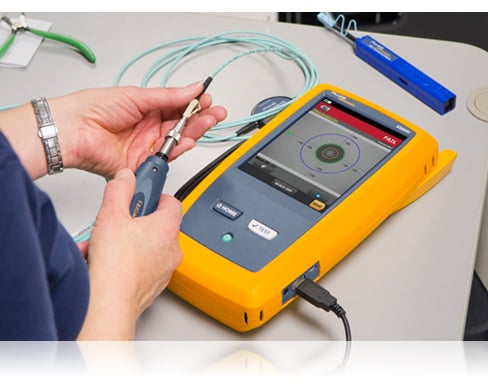The optical fibre diameter analyser ensures precise measurements for fibre optics.
The optical fibre diameter analyser ensures precise measurements for fibre optics.
Blog Article
Checking Out the Advantages of Optical Fibre Testing for Boosted Interaction Systems
The significance of optical fiber testing in modern interaction systems can not be overemphasized, as it works as a foundation for guaranteeing network reliability and efficiency. Making use of sophisticated methodologies such as Optical Time-Domain Reflectometry (OTDR) and insertion loss analysis, organizations can not just recognize faults yet also enhance their arrangements. This positive screening method has extensive ramifications for signal high quality and operational performance, elevating the inquiry of how these practices add to lasting sustainability in an ever-evolving technological landscape. Comprehending these dynamics is necessary for stakeholders intending to maintain an affordable edge.
Value of Optical Fiber Testing
The value of optical fibre testing can not be overstated in today's data-driven atmosphere. As organizations significantly count on high-speed data transmission for everyday operations, the integrity and performance of optical fiber networks are extremely important. Examining guarantees that these networks can sustain the substantial quantities of data created and sent flawlessly, fostering effective interaction and connection.
Optical fibre screening offers numerous critical functions, including verifying installment top quality, determining potential mistakes, and identifying general system efficiency. Regular screening can stop costly downtimes and service disturbances, permitting organizations to maintain functional connection. It helps in conformity with sector criteria and policies, ensuring that fibre optic installments fulfill called for specifications for safety and integrity.
In addition, screening can boost the long life of fiber optic systems. By proactively recognizing concerns such as signal loss, depletion, or adapter failures, companies can resolve issues prior to they intensify, therefore extending the life of their infrastructure. In recap, optical fiber screening is not simply a technological need but a calculated investment that enhances network dependability, enhances performance, and inevitably supports the development and efficiency of modern-day communication systems.
Trick Evaluating Approaches

OTDR is a vital method made use of to identify faults, procedure splice losses, and analyze the overall stability of a fiber optic link. By sending a pulse of light down the fibre and examining the mirrored light, specialists can identify areas of mistakes and evaluate the network's performance over fars away.
Insertion loss screening gauges the amount of signal loss that happens when light go through a link or splice. This method is important for verifying that links fulfill specific loss limits, which is important for he said maintaining ideal original site performance in communication systems.
Optical return loss testing evaluates the quantity of light reflected back in the direction of the source due to imperfections in the fibre or connections. High return loss worths show far better efficiency and lowered signal destruction.
With each other, these screening methods offer an extensive analysis of fibre optic networks, ensuring their integrity and capability in varied interaction applications.
Influence On System Performance
Efficient optical fibre testing straight affects the general performance of interaction systems. By making certain the integrity of fibre optic cables, screening recognizes prospective faults such as attenuation, splice loss, and adapter imbalance. These problems can considerably deteriorate signal top quality, leading to interruptions and lowered data transmission speeds.

Additionally, normal optical fibre screening adds to lasting system sustainability. It enables very early detection of deterioration, permitting timely upkeep and upgrades before you can try these out major failings occur. This not just extends the life-span of the infrastructure however additionally guarantees that interaction systems remain competitive in regards to efficiency.
Cost-Effectiveness and Efficiency
Cost-effectiveness is a critical consideration in the implementation and upkeep of optical fiber networks. Executing durable optical fibre testing treatments can significantly decrease functional prices by identifying issues before they intensify right into significant problems. optical fibre testing equipment. By spotting faults, attenuation, and various other performance obstacles early, organizations can prevent expensive fixings and downtime, which can interfere with services and lead to income loss
In addition, effective testing methodologies simplify the setup procedure, enabling specialists to function a lot more successfully. This translates to decrease work costs and faster task completion times. Advanced screening devices, such as Optical Time Domain Reflectometers (OTDRs), makes it possible for an accurate assessment of fibre top quality, guaranteeing that only optimal products are used, therefore reducing waste.
Normal testing additionally adds to better source appropriation. By comprehending the network's performance, companies can make informed decisions concerning upgrades and growths, guaranteeing that financial investments are made where they are most needed. In recap, optical fibre screening boosts cost-effectiveness and effectiveness, sustaining the long-term sustainability and competition of interaction systems in an increasingly requiring market.
Ensuring Long-Term Dependability
Applying extensive optical fiber testing not just boosts cost financial savings and functional efficiency however additionally plays a critical duty in ensuring the long-lasting integrity of interaction networks. Consistent testing methods, consisting of depletion and bandwidth evaluations, aid recognize potential deterioration in fibre efficiency prior to it leads to service interruptions.
By utilizing sophisticated screening techniques, network drivers can pinpoint mistakes or weaknesses in the fiber framework, permitting prompt remediation. This proactive approach reduces downtime, making sure that interaction systems stay practical and reliable. In addition, normal screening adds to the growth of an extra resistant network, as operators can adapt and optimize their infrastructure based on real-time data understandings. optical fibre diameter analyser.
Furthermore, making sure conformity with market standards through optical fiber screening strengthens the quality and honesty of the whole communication system. This adherence not only bolsters self-confidence amongst stakeholders but also straightens with regulative requirements, which are progressively strict.
Conclusion
In conclusion, optical fiber screening serves as an essential part in enhancing interaction systems. By using various screening approaches, such as OTDR and insertion loss evaluations, networks can attain optimal performance and integrity.
Report this page